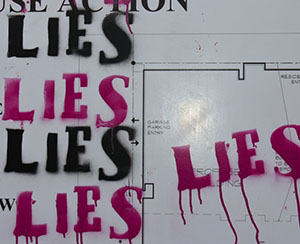
2014 saw the rise and fall of a curious statistic whose own authors tried to play down its weight: the claim that one in five women will be victims of sexual assault during their college career.
Much like Doonesbury‘s continued faith in the story of “Jackie” at the University of Virginia, however, the campus progressives at Generation Progress continue to hold out 1-in-5 as unquestionable scripture.
In its year-end wrap-up of liberal successes, the group touted its role in the national conversation on campus sexual assault, including helping the White House launch the It’s On Us awareness campaign:
On January 22, 2014, the White House announced the Task Force to Protect Students from Sexual Assault. In April, the Task Force released their first report, Not Alone, which laid out some startling statistics—one in five women is sexually assaulted in college, 75 to 80 percent of survivors know their attacker, and most often, they do not report the crime.
The group also celebrates California’s new affirmative-consent law for college campuses and its implication that drunk sex is by definition rape. But let’s go back to that 1-in-5 statistic.
Generation Progress may be one of the few organizations still refusing to acknowledge the stat, from a Justice Department report, is full of caveats – it’s based on a 2007 Web-based survey of two large public universities and had a low response rate, to say nothing of how it worded questions.
In addition to skeptics of campus administrators who are rushing to dump due process from adjudications of sexual-assault allegations, mainstream media increasingly say the 1-in-5 stat can’t be trusted.
Most recently, The Atlantic‘s Olga Khazan wrote about a sociologist working with men on campus to “discover the best male-oriented efforts to prevent sexual assault, and then replicate them nationwide” – an effort that sounds more fruitful than simply prejudging all men as latent rapists.
Perhaps Khazan’s editor inserted this parenthetical, but it’s good to see nonetheless:
While not a new problem, rape on campus has become a newly conspicuous one following a wave of antirape activism and heightened media attention to colleges’ sexual-assault policies. Even President Obama has weighed in, citing the oft-repeated (though widely contested) statistic that one in five female students is raped at some point in her college career.
Before The Atlantic, PolitiFact also pointed to the same caveats around response rate and representation, and not just in the 2007 survey:
James Fox, a professor of criminology, law and public policy at Northeastern University, told PolitiFact National in May that the “one-in-five statistic shouldn’t just be taken with a grain of salt, but the entire shaker.” …
[Regarding MIT’s own “campus climate” survey,] the researchers found the undergraduates answered the question differently when asked if they had been “sexually assaulted or raped” and were allowed to apply their own definitions to the terms. Under those conditions, 11 percent of the women answered “yes.”
The New York Times editorial board won’t stand behind 1-in-5 either, citing PolitiFact. Writing in USA Today, University of Tennessee law professor Glenn Reynolds noted the Justice Department study’s authors don’t approve of how it’s been portrayed.
Substantial credit should go to Slate‘s Emily Yoffe for her thorough reporting on the “campus rape overcorrection” and the due-process infringements against accused students. She actually interviewed the academics behind the scary figures:
There are approximately 12 million female college students in the U.S. (There are about 9 million males.) I asked the lead author of the study, Christopher Krebs, whether the [study] represents the experience of those millions of female students. His answer was unequivocal: “We don’t think one in five is a nationally representative statistic.” It couldn’t be, he said, because his team sampled only two schools. “In no way does that make our results nationally representative,” Krebs said. And yet President Obama used this number to make the case for his sweeping changes in national policy.
Yoffe also pointed to the statistical gymnastics that gave us the even less credible 1-in-4 alternative – the Sexual Victimization of College Women study in 2000 from the Justice Department:
The study itself, however, found a completed rape rate among its respondents of 1.7 percent. How does a study that finds less than 2 percent of college women in a given year are raped become a 25 percent likelihood? In addition to the 1.7 percent of victims of completed rape, the survey found that another 1.1 percent experienced attempted rape. As the authors wrote, “[O]ne might conclude that the risk of rape victimization for college women is not high; ‘only’ about 1 in 36 college women (2.8 percent) experience a completed rape or attempted rape in an academic year.”
But the authors go on to make several assumptions that ratchet up the risk. The study was carried out during the spring and asked women to describe any assaults experienced during that academic year. The researchers decided to double the numbers they received from their subjects, in order to extrapolate their findings over an entire calendar year, even as they acknowledged that this was “problematic,” as students rarely attend school for 12 months. That calculation brought the incidence figure to nearly 5 percent. Although college is designed to be a four-year experience, the authors note that it takes students “an average” of five years, so they then multiplied their newly-arrived-at 5 percent of student victims by five years, and thus they conclude: “The percentage of completed or attempted rape victimization among women in higher educational institutions might climb to between one-fifth and one-quarter.”
Even under the Clery Act’s broad definition of “forcible sexual offense” – which includes fondling without force – and President Barack Obama’s assertion that the reporting rate for sexual assault is only 12 percent, “that would suggest there were 32,500 assaults in 2012, reported and not, or a 0.27 percent incidence,” Yoffe says.
Perhaps further research on a broader scale – face-to-face interviews, minimal selection bias and questions that don’t encourage students to see every nonverbal or inebriated encounter as devoid of consent – will reveal a statistic that’s not much better than 1-in-5.
But until that day arrives, credible media outlets appear to be showing some much-needed skepticism toward stats that simply can’t be relied upon for sweeping public policy changes.
Perhaps Generation Progress should rebrand as “Generation Regress.”
Greg Piper is an assistant editor at The College Fix. (@GregPiper)
Like The College Fix on Facebook / Follow us on Twitter
IMAGE: Jesse Means/Flickr







Please join the conversation about our stories on Facebook, Twitter, Instagram, Reddit, MeWe, Rumble, Gab, Minds and Gettr.